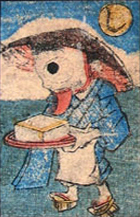Hitotsume-kozō
Hitotsume-kozō (Japanese: 一つ目小僧) are a type of Yōkai or supernatural creature found in Japanese folklore. They are characterized by their single, large eye located in the center of their face, a feature from which their name is derived; "hitotsume" meaning "one eye" and "kozō" referring to a young boy or monk. These creatures are often depicted wearing traditional monk robes, further emphasizing their namesake. Despite their potentially intimidating appearance, Hitotsume-kozō are not typically considered dangerous, often portrayed as mischievous rather than malevolent.
Description[edit | edit source]
Hitotsume-kozō are relatively small creatures, usually the size of a child or small adult. Their most distinctive feature is undoubtedly their single, large eye, which dominates their facial features. They are often depicted wearing the robes of a Buddhist monk, with their bald heads adding to their monk-like appearance. In many stories, they appear suddenly to travelers or inhabitants of homes, startling them, but rarely causing any real harm.
Behavior[edit | edit source]
The behavior of Hitotsume-kozō varies across tales, but they are commonly known to enjoy surprising humans. Their actions are more akin to playful pranks rather than anything with malicious intent. They might appear on remote roads or within households, quickly revealing themselves before disappearing just as fast. Despite their eerie appearance, encounters with Hitotsume-kozō are typically considered omens of good fortune or merely harmless events.
Cultural Significance[edit | edit source]
In Japanese culture, Hitotsume-kozō occupy a unique place in the pantheon of yōkai. They are among the myriad creatures that populate Japanese tales, contributing to the rich tapestry of folklore that teaches lessons, entertains, and embodies cultural values and fears. Like many yōkai, Hitotsume-kozō reflect the animistic aspects of Japanese Shinto beliefs, where spirits inhabit all things, and the world is full of unseen forces.
In Popular Culture[edit | edit source]
Hitotsume-kozō have made appearances in various forms of media, from traditional Kabuki and Noh theater to modern anime and manga. Their iconic look makes them easily recognizable, and they are often used to add a touch of the supernatural to stories set in both historical and contemporary settings. Their depiction in popular culture tends to lean towards their more benign, playful nature, making them a favorite among the pantheon of yōkai characters that appear in Japanese entertainment.
See Also[edit | edit source]
Search WikiMD
Ad.Tired of being Overweight? Try W8MD's physician weight loss program.
Semaglutide (Ozempic / Wegovy and Tirzepatide (Mounjaro / Zepbound) available.
Advertise on WikiMD
|
WikiMD's Wellness Encyclopedia |
| Let Food Be Thy Medicine Medicine Thy Food - Hippocrates |
Translate this page: - East Asian
中文,
日本,
한국어,
South Asian
हिन्दी,
தமிழ்,
తెలుగు,
Urdu,
ಕನ್ನಡ,
Southeast Asian
Indonesian,
Vietnamese,
Thai,
မြန်မာဘာသာ,
বাংলা
European
español,
Deutsch,
français,
Greek,
português do Brasil,
polski,
română,
русский,
Nederlands,
norsk,
svenska,
suomi,
Italian
Middle Eastern & African
عربى,
Turkish,
Persian,
Hebrew,
Afrikaans,
isiZulu,
Kiswahili,
Other
Bulgarian,
Hungarian,
Czech,
Swedish,
മലയാളം,
मराठी,
ਪੰਜਾਬੀ,
ગુજરાતી,
Portuguese,
Ukrainian
Medical Disclaimer: WikiMD is not a substitute for professional medical advice. The information on WikiMD is provided as an information resource only, may be incorrect, outdated or misleading, and is not to be used or relied on for any diagnostic or treatment purposes. Please consult your health care provider before making any healthcare decisions or for guidance about a specific medical condition. WikiMD expressly disclaims responsibility, and shall have no liability, for any damages, loss, injury, or liability whatsoever suffered as a result of your reliance on the information contained in this site. By visiting this site you agree to the foregoing terms and conditions, which may from time to time be changed or supplemented by WikiMD. If you do not agree to the foregoing terms and conditions, you should not enter or use this site. See full disclaimer.
Credits:Most images are courtesy of Wikimedia commons, and templates Wikipedia, licensed under CC BY SA or similar.
Contributors: Prab R. Tumpati, MD

